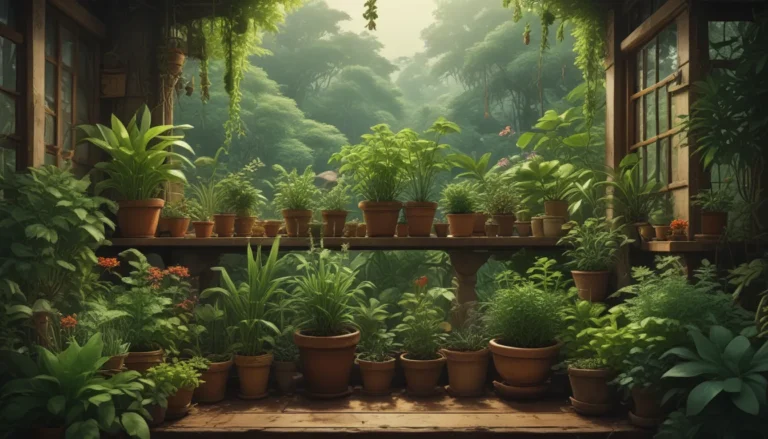Why Your Pumpkin Vine Isn’t Blooming: 5 Common Causes

So, you planted those pumpkin seeds, watched them sprout, and grow into vibrant vines with lush leaves. But where are the flowers? If you’re scratching your head wondering why your pumpkin vines aren’t blooming, don’t worry, we’ve got you covered.
In this article, we’ll explore the top reasons why your pumpkin plants may not be producing flowers. From timing to soil conditions to sunlight and fungal infections, we’ll address the main culprits and provide you with tips on how to get those pumpkins blooming in no time.
Why Isn’t My Pumpkin Blooming?
When it comes to understanding why your pumpkin vines aren’t blooming, there are a few key factors to consider. Let’s dive into the top five reasons your pumpkin plants may be holding back on those beautiful blossoms.
1. Timing
Timing is crucial when it comes to pumpkin flowering. Typically, you should expect to see flowers around eight weeks after germination, which is about halfway through the plant’s total growing time. Keep an eye out for male flowers, which appear first, followed by female flowers containing the ovary. Remember that pumpkin flowers only last for a day, so timing is essential for successful pollination.
Tips for Timing:
– Check the date of germination to determine if the plant is ready to bloom.
– Be vigilant in observing the vines for signs of flowers throughout the day to catch them at their peak.
2. The Soil
If your pumpkin vines are lacking in flowers, it could be due to imbalanced soil nutrients. Too much nitrogen can lead to lush foliage but hinder flower production. Ensure your plants are receiving adequate phosphorus, which is essential for setting fruit and promoting flowering. Consider feeding your pumpkins with a 5-10-10 NPK fertilizer to boost phosphorus levels.
Soil Solution:
– Use bone meal fertilizer rich in phosphorus to encourage flowering.
– Plant nitrogen-hungry crops like corn alongside pumpkins to balance soil nutrients.
3. The Sun
Pumpkin plants thrive in full sunlight, requiring at least six to eight hours of sun exposure daily. Insufficient sunlight can result in weak vines and limited flower production. Assess your plant’s sunlight exposure and consider relocating it to a sunnier spot if necessary.
Sunlight Strategies:
– Monitor daily sun exposure and adjust plant placement for optimal light conditions.
– Transplant to a sunnier location to promote healthy growth and flowering.
4. Too Much Heat
High temperatures can stress pumpkin plants, causing them to drop immature buds before they bloom. While pumpkins love sun, excessive heat can deter flower production as the plant redirects energy to survival mode. Protect your plants from intense heat by providing adequate water and using light-colored mulch to deflect heat.
Cooling Tips:
– Water plants generously during hot spells to prevent stress.
– Shield plants with shade cloth to regulate temperature and promote flowering.
5. There’s a Fungus Among Us
Fungal infections, such as powdery mildew, can hinder pumpkin flower production by affecting overall plant health. Keep an eye out for white powdery substances on leaves and vines, which indicate fungal presence. Promptly remove infected plant parts and treat with organic fungicides to prevent further spread.
Fungal Defense:
– Use preventative fungicides in wet, rainy climates to protect against fungal diseases.
– Maintain proper airflow around plants to reduce moisture and fungal growth.
By addressing these common issues, you can help your pumpkin vines thrive and bloom with vibrant flowers. Remember to monitor your plants regularly, provide essential nutrients, and create optimal growing conditions to encourage healthy flowering.
Conclusion
Growing pumpkins can be a rewarding experience, but it’s essential to understand the factors that influence flower production. By following these tips and troubleshooting potential issues, you can increase your chances of a successful pumpkin harvest.
So, keep an eye out for those blossoms, tend to your pumpkin vines with care, and get ready to enjoy a bountiful harvest of pumpkins. Happy gardening!
Have you encountered challenges with getting your pumpkin vines to bloom? Share your experiences in the comments below!
For more information on growing pumpkins, check out our other articles:
– How to Grow Your Own Pumpkins
– How to Choose the Best Halloween Pumpkins to Grow in Your Garden
– When and How to Trim Pumpkin Vines
– 5 Reasons Why Your Pumpkin Isn’t Producing Fruit
Remember, a little TLC goes a long way in helping your pumpkin plants reach their full blooming potential. Start nurturing those vines today for a successful pumpkin-growing season!
*Photos by Laura Melchor





